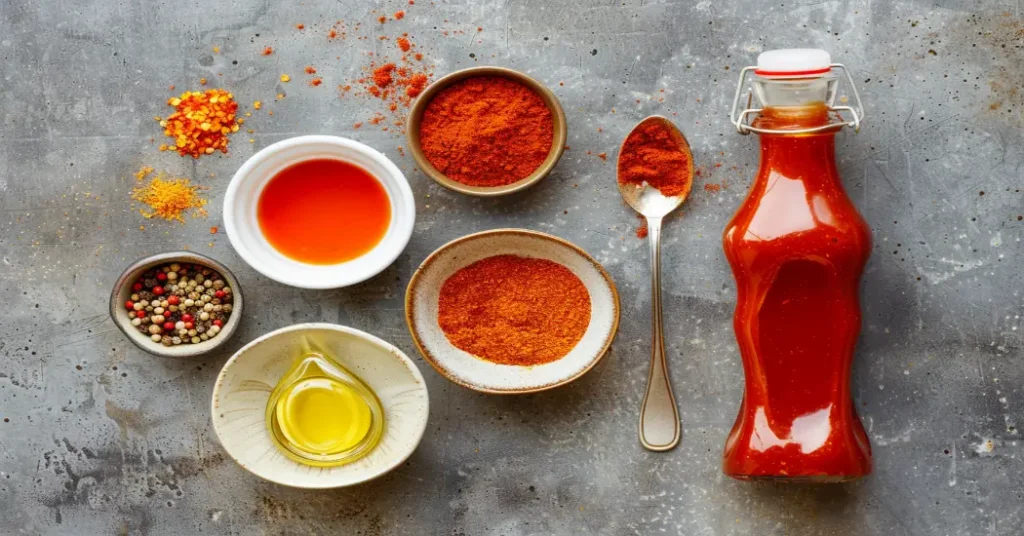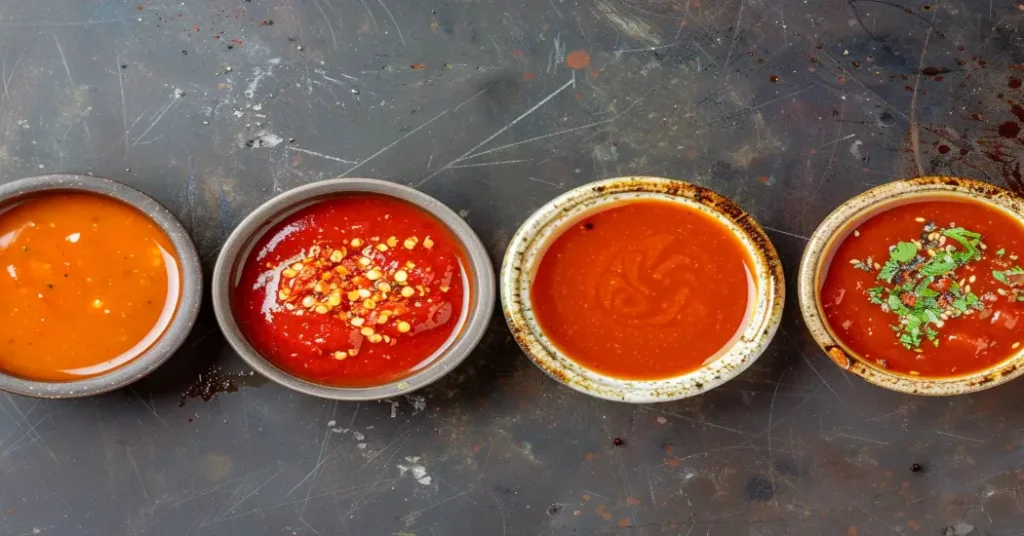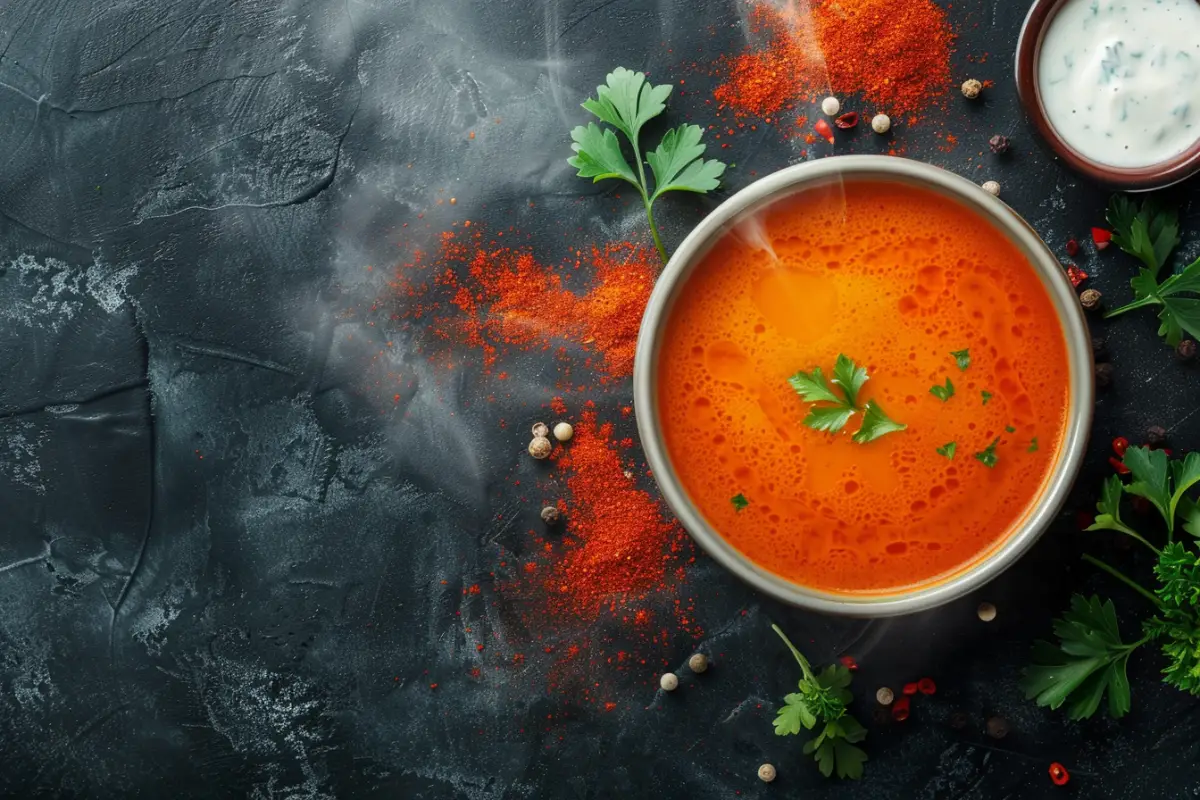Buffalo sauce is a favorite among those who love a little kick in their food, but exactly how spicy is it? Often associated with classic buffalo wings, this sauce has earned a reputation for delivering heat. However, the spiciness of buffalo sauce can vary, and it’s important to understand what makes it spicy and how it compares to other sauces.
This article dives into the ingredients that contribute to the spice level of buffalo sauce, how to adjust it, and whether it’s suitable for everyone. For those wondering, is buffalo sauce spicy, the answer depends on how it’s made and your personal heat tolerance.
What Is Buffalo Sauce?
Buffalo sauce is a tangy, spicy condiment that originated in Buffalo, New York, where it was first used to coat chicken wings. The sauce is a combination of hot sauce, butter, and a few other seasonings. The hot sauce provides the heat, while the butter helps to mellow out the spice, giving it a creamy and smooth texture.
Buffalo sauce has since become a staple in American cuisine, especially for chicken wings, but its versatility allows it to be used in other dishes like buffalo chicken pizza, wraps, and even as a salad dressing.
The sauce is typically made by mixing melted butter with a vinegar-based hot sauce, such as Frank’s RedHot. The ratio of hot sauce to butter varies, depending on how spicy you want the sauce to be. In its most basic form, buffalo sauce contains just a few ingredients, but how you prepare it can drastically alter its heat level and flavor.
Buffalo sauce has a unique balance of tanginess from the vinegar and spice from the chili peppers, making it different from other types of hot sauces like sriracha or Tabasco. While those sauces may have sharper or more concentrated flavors, buffalo sauce’s richness comes from the butter, which tones down the heat and adds a smooth finish.
If you’re curious about experimenting with other hot sauces or variations of buffalo sauce, check out this Quora discussion.
What Makes Buffalo Sauce Spicy?

The key to understanding how spicy buffalo sauce is lies in its ingredients—specifically, the hot sauce used as its base. Most buffalo sauces start with a vinegar-based hot sauce, like Frank’s RedHot, which contains cayenne peppers. Cayenne peppers are known for their moderate heat level and add a sharp, biting flavor to the sauce.
Capsaicin: The Source of Heat
The spiciness in buffalo sauce comes from capsaicin, the compound found in chili peppers that produces a burning sensation. Capsaicin binds to receptors on your taste buds, triggering the heat. The more capsaicin present, the spicier the sauce. In buffalo sauce, the level of spiciness is directly related to the type and amount of hot sauce used.
Buffalo sauce made with a high concentration of hot sauce will naturally be spicier, while adding more butter can reduce the heat. Some people also add a bit of sugar or honey to the sauce to balance the spice with sweetness. The spiciness of buffalo sauce can also vary based on the type of hot sauce used, as each brand has its own unique heat level. For instance, sauces made with habanero peppers are much spicier than those made with cayenne or jalapeño peppers.
Scoville Heat Units
The Scoville scale is used to measure the heat of chili peppers and hot sauces. While pure capsaicin ranks at a whopping 16 million Scoville heat units (SHU), cayenne peppers used in buffalo sauce generally fall between 30,000 to 50,000 SHU. This makes buffalo sauce spicy enough to deliver a noticeable kick but not overpowering for most people.
If you’re curious about the Scoville scale and how different hot sauces compare, this Wikipedia entry explains the heat levels in detail.
How Spicy Is Buffalo Sauce Compared to Other Sauces?

Buffalo sauce is spicy, but how does it compare to other popular hot sauces? Let’s break it down.
Buffalo Sauce vs. Sriracha
Sriracha is a popular chili-based sauce known for its garlicky sweetness and moderate spice. While sriracha has a thicker texture, buffalo sauce is smoother due to the butter. In terms of heat, sriracha tends to be spicier than mild buffalo sauce but less spicy than hot buffalo sauce.
Buffalo Sauce vs. Tabasco
Tabasco sauce is thinner and packs more vinegar, delivering a sharp and tangy heat. It rates higher on the Scoville scale (2,500 to 5,000 SHU) than most mild buffalo sauces. However, extra hot buffalo sauce can rival or even surpass Tabasco in spiciness.
Buffalo Sauce vs. Cholula
Cholula is another widely used hot sauce. It’s milder and has a balanced flavor with a slight tang. Cholula’s Scoville rating is around 1,000 SHU, making it less spicy than typical buffalo sauce.
In conclusion, buffalo sauce can range from mild to very spicy, depending on how much hot sauce you use. When compared to other sauces like sriracha or Tabasco, buffalo sauce sits comfortably in the middle, offering a blend of spice and creaminess. If you’re wondering how to balance the spice in different dishes, check out this guide.
Different Levels of Spiciness in Buffalo Sauce
Buffalo sauce isn’t a one-size-fits-all. You can adjust the heat level to suit your taste. Here are the common levels of buffalo sauce spiciness:
Mild Buffalo Sauce
Mild buffalo sauce offers just a hint of heat. It’s perfect for those who enjoy the flavor of buffalo sauce but can’t handle much spice. The butter in mild buffalo sauce helps tone down the heat, making it more approachable for everyone.
Medium Buffalo Sauce
Medium buffalo sauce strikes a balance. It’s spicy enough to give you a kick but not so hot that it overpowers the dish. This version is often served with classic buffalo wings and is the go-to for many people.
Hot Buffalo Sauce
Hot buffalo sauce brings the heat. It uses more hot sauce and less butter, letting the spice take center stage. This is for those who love a bold, fiery flavor.
Extra Hot Buffalo Sauce
Extra hot buffalo sauce turns up the heat even more. For people who crave intense spiciness, this version delivers. It’s a favorite among those with a high tolerance for spicy foods.
No matter which level of heat you prefer, buffalo sauce can be customized to your taste. If you want to explore more spicy recipes, this Reddit thread shares some great ideas.
How to Make Buffalo Sauce Less Spicy
Not everyone enjoys the heat of buffalo sauce. Luckily, you can make it milder without losing flavor. Here are a few simple ways to tone down the spiciness:
Add More Butter
Butter is the key to balancing buffalo sauce. Adding extra butter helps smooth out the sauce and reduces the heat. This works especially well when making wings or dipping sauces. You still get the buffalo flavor but with less spice.
Use Cream or Milk
If you want a richer, less spicy buffalo sauce, try adding cream or milk. Dairy naturally tones down the heat from the hot sauce. Stir in a few tablespoons of cream for a smooth, creamy sauce that’s gentler on your taste buds.
Sweeten It Up
Another way to reduce the heat is to add something sweet. Honey, brown sugar, or even a dash of maple syrup can balance out the spice. A little sweetness goes a long way in making buffalo sauce less intense. For example, honey buffalo wings are a popular way to enjoy the flavor without too much burn.
Reduce the Hot Sauce
You can also adjust the recipe by simply using less hot sauce. This makes the sauce milder from the start. To keep the tangy flavor, add a little more vinegar or lemon juice to make up for the reduced hot sauce.
These simple tricks can help make buffalo sauce more enjoyable for those with lower spice tolerance.
What Dishes Use Buffalo Sauce?

Buffalo sauce is more than just a wing sauce. It can add flavor to many dishes, from appetizers to main courses. Here are some popular ways to use buffalo sauce:
Buffalo Wings
Of course, the most famous dish is buffalo wings. This classic dish coats crispy fried chicken wings in a spicy, buttery sauce. Whether you prefer mild, medium, or extra hot, buffalo wings are a crowd favorite.
Buffalo Chicken Pizza
Buffalo sauce also makes a great pizza topping. It combines shredded chicken with buffalo sauce, mozzarella cheese, and a drizzle of ranch or blue cheese. The tangy and spicy sauce works well with the creamy cheese, making it a popular alternative to traditional pizza.
Buffalo Wraps
You can also use buffalo sauce in wraps. Buffalo chicken wraps are a quick and tasty meal, with grilled or fried chicken, buffalo sauce, lettuce, and cheese wrapped in a tortilla. It’s a simple way to enjoy the flavor of buffalo sauce without the mess of wings.
Buffalo Chicken Salad
For a healthier option, buffalo chicken can be added to salads. The spiciness of the sauce pairs perfectly with the crunch of fresh greens and a drizzle of ranch dressing. It’s a lighter way to enjoy the bold flavor of buffalo sauce.
Buffalo sauce brings heat and tang to many dishes, making it versatile for more than just wings. If you want to get creative with buffalo sauce, this recipe on buffalo-based dishes can inspire your next meal.
Is Buffalo Sauce Suitable for Everyone?
While buffalo sauce is delicious, it’s not for everyone, especially those who don’t tolerate spice well. The heat in buffalo sauce can be too much for some, even at its mildest level. However, there are ways to make it more enjoyable for people with lower spice tolerance.
Serving to a Crowd
When serving buffalo sauce to a group, it’s important to consider everyone’s spice tolerance. You can offer different levels of spiciness, such as mild, medium, and hot, to suit a variety of preferences. Another option is to serve buffalo sauce on the side so that each person can add it to their food based on their own heat tolerance.
Adjusting Spice Levels
As mentioned earlier, adding more butter or a dairy product like sour cream or ranch dressing can help tone down the heat. These ingredients balance out the spiciness while keeping the tangy flavor intact. For those who really can’t handle the heat, a sweet buffalo sauce made with honey or brown sugar is a great alternative that still gives you the familiar buffalo flavor without the burn.
Health Considerations
Spicy foods, including buffalo sauce, can sometimes cause discomfort for people with sensitive stomachs, acid reflux, or heartburn. If you’re serving buffalo sauce to someone with these conditions, it’s best to offer milder versions or provide alternatives like ranch or barbecue sauce.
Buffalo sauce isn’t everyone’s favorite, but with some adjustments, most people can enjoy it. Offering a variety of spice levels and balancing the heat with dairy or sweetness ensures that everyone can enjoy the flavor without the discomfort.
Conclusion
So, is buffalo sauce spicy? The answer depends on how it’s made and how much heat you can handle. Buffalo sauce, at its core, is a spicy blend of hot sauce and butter. However, the level of spiciness can be adjusted to suit personal preferences. Whether you like it mild, medium, or extra hot, buffalo sauce offers a unique combination of tangy, spicy, and creamy flavors.
This versatile sauce works with a variety of dishes, from wings to pizza, wraps, and even salads. While it may not be for everyone, with a few adjustments, buffalo sauce can be adapted to different spice levels, making it a favorite for many.
